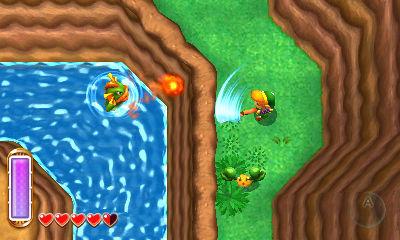
Nintendo has always had an odd relationship with sequels. The Metroid games have always maintained a strict chronology while the Mario games have never kept any kind of coherent thread going between them. The Legend of Zelda’s continuity, meanwhile, has been especially thorny. Majora’s Mask directly followed Ocarina of Time, while The Wind Waker came thousands of years after both (while still being related). Typically these pseudo sequels have always followed the chronology of the most recent marquee release. Not so with the Nintendo 3DS’ The Legend of Zelda: A Link Between Worlds, a direct sequel to 1991’s The Legend of Zelda: A Link to the Past on Super Nintendo. Does the old top-down Zelda style thrive in the modern age?
Story/Concept
A Link to the unknown. Nintendo’s brief sample of the new handheld Zelda is devoid of specifics, which is unusual for the series. The company usually provides a little context, but this return to the Hyrule split into Dark and Light worlds is story-free. The game does take place in an almost identical Hyrule field from the original. Here is Link’s house, Hyrule castle, the little mountain area, and even Sage Sarashala’s hermitage near the old first dungeon. There are small differences in the terrain that take advantage of the game’s new style of play, but only the devoted Link to the Past player will spot them.
Gameplay
Same taste, less filling. The demo takes you into the first dungeon, and while it looks the same on the outside the inside demonstrates how different this new Zelda is. Link feels a bit swifter than he used to, but the big differences are items, and his new ability to become a painting on the environment walls. Using arrows, bombs, the hammer, and fire wand all use up chunks of a meter on the side of the screen. Use up the meter, and you have to wait for it to refill.
Link can also hide in walls of the dungeon to reach new areas. See a treasure chest on a ledge you can’t reach? Walk up the stairs on an adjacent platform, cling to the wall, and pop back out near the chest. This, however, also uses the meter, so the game quickly becomes about managing how fast you deplete the meter as well as just fighting enemies and figuring out where you’re supposed to go. It’s swift, fun, and very new for Zelda.
Presentation
Hi-tech, low res. Nintendo doesn’t make sprite-based games anymore it seems. And that’s a shame, because while A Link Between Worlds is fine looking and well made in 3D, it’s butt ugly compared to the vibrant, colorful 2D pixel art of A Link to the Past. Also problematic is the 3D effect. I typically enjoy the stereoscopic 3D in games like Super Mario 3D Land and Luigi’s Mansion, but the speedy action in A Link Between Worlds makes it the screen a blurry mess in 3D. It’s far too early to judge the game’s final presentation, though. Nintendo games always evolve between demos like these and what’s ultimately put out. The new look might be quite fetching in full.

Takeaway
The Legend of Zelda: A Link to the Past may have been replaced by Ocarina of Time as the signature entry in the Zelda series, but it’s the one whose formula looms largest in the pantheon. To see the game play so differently, even in such a small sample makes this the most exciting game in Nintendo’s upcoming calendar. Everything old is new again it seems. Now all there is to do is count the days until the game comes out this fall.




